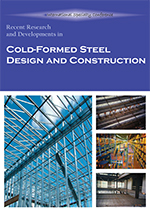Session Dates
24 Aug 2012 - 25 Aug 2012
Abstract
This paper presents an approximate solution for the critical elastic buckling stress of cold-formed steel C- and Z-section members including cross-section connectivity. The elastic buckling solution is developed to support the extension of the Direct Strength Method to the shear ultimate limit state, where the cross sectional critical elastic shear buckling stress (load) is employed to predict shear capacity. The shear buckling stress and buckled half-wavelength are calculated with a classical energy solution for a thin plate with edges rotationally restrained. Rotational stiffness expressions in the AISI S100-07 specification, originally derived for distortional buckling of C- and Z-sections, are used with the energy solution to calculate the rotational restraint provided to the web flange juncture by the flanges. The approach is validated with thin shell finite element eigen-buckling analysis.
Department(s)
Civil, Architectural and Environmental Engineering
Research Center/Lab(s)
Wei-Wen Yu Center for Cold-Formed Steel Structures
Meeting Name
21st International Specialty Conference on Cold-Formed Steel Structures
Publisher
Missouri University of Science and Technology
Document Version
Final Version
Rights
© 2012 Missouri University of Science and Technology, All rights reserved.
Document Type
Article - Conference proceedings
File Type
text
Language
English
Recommended Citation
Aswegan, Kevin and Moen, Cristopher D., "Critical Elastic Shear Buckling Stress Hand Solution for C- and Z-sections Including Cross-section Connectivity" (2012). CCFSS Proceedings of International Specialty Conference on Cold-Formed Steel Structures (1971 - 2018). 2.
https://scholarsmine.mst.edu/isccss/21iccfss/21iccfss-session4/2
Critical Elastic Shear Buckling Stress Hand Solution for C- and Z-sections Including Cross-section Connectivity
This paper presents an approximate solution for the critical elastic buckling stress of cold-formed steel C- and Z-section members including cross-section connectivity. The elastic buckling solution is developed to support the extension of the Direct Strength Method to the shear ultimate limit state, where the cross sectional critical elastic shear buckling stress (load) is employed to predict shear capacity. The shear buckling stress and buckled half-wavelength are calculated with a classical energy solution for a thin plate with edges rotationally restrained. Rotational stiffness expressions in the AISI S100-07 specification, originally derived for distortional buckling of C- and Z-sections, are used with the energy solution to calculate the rotational restraint provided to the web flange juncture by the flanges. The approach is validated with thin shell finite element eigen-buckling analysis.



